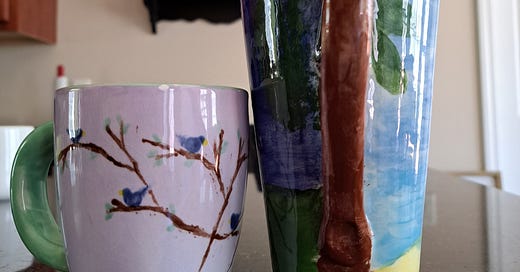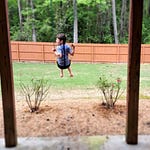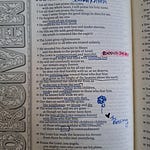You might remember from my post, The Flood, my family is recovering from a major water leak in our home. Though there was much to be thankful for, the ordeal has left us with a fair amount of “clean up,” which has included purging, decluttering, and rearranging.
One stint of this process led me to reorganizing our coffee mug cabinet. Having reached some threshold for annoyance that the precious, breakable things live in such precarious stacks, I decided to part with some of the old, chipped, or plain ones and to bring forth order and function for the ones most beloved.
My full commitment to this project took me even to the highest shelf, the one I have to stand on a chair to reach, where the most precious and novel coffee cups reside. There I found several old favorites, one-of-a-kind mugs that I treasure.
There’s the tall mug I painted at a pottery shop in Seaside, Florida, while on vacation there with my sister. The long, slender handle of the cup is a tree trunk, but the top of the tree sprouts into two different types of leaves. One side of the mug is painted as a pine, with the backdrop of a starry, forest night, the other half of the mug is painted with palm leaves, over a background of warm, sunny sand and ocean waves. I guess I really have always loved the tension of opposites.
Then there is a shorter, dainty mug, also painted at a pottery shop, but this time in Carrollton, Georgia, where I lived at the time. The gathering was part of my bachelorette party, so all my bridesmaids each went home with a personalized piece that day. Mine was painted with (again) branches of a tree, but lit upon the branches were six little birdies, representing me and the special friendships with each of my bridesmaids.
Both of these had been relegated like works in a museum to pristine status on this unreachable shelf, though beautiful and preserved, my heart suddenly ached for realizing how this had also made them unused, unloved, and unpurposed.
There is a therapeutic model called Internal Family Systems1, which recognizes different parts of us that coexist internally. That day I definitely heard a vocal part piping up.
“Put these back on the high shelf, they are for special occasions. You don’t want to risk them getting broken. They are one of a kind. You can’t replace them if something happens. Once they are gone, they will be gone for good. You can enjoying thinking of them in your heart, knowing they are safe and sound tucked away in the cupboard.”
But, like the dust collecting on my precious cups, I could see dust on this train of thought and recognized it as an old way of thinking. This part was from a branch of my internal family that worships an idol of perfectionism. They live on scarcity street where there’s only one chance to get things right, mistakes will ruin the trajectory of your life forever, and you better just hope you guess correctly the path that will make you worthy of love and acceptance. I let these internal family members pretty much run my adolescence and early adulthood years.
“Hello…” I greeted the old way of thinking with compassion and respect. “Thank you for loving these pieces so much that you want to protect them from harm. But I think now we can give them life by using them. It will bring me joy to use them on a daily basis and if something happens where they get broken, which sometimes does, it will be okay.”
Speaking from this place is what the IFS model would call the “Core Self,” which is the authentic, calm, compassionate, and genuine disposition inside of all of us, in our most healed, whole version of ourselves.
This core self is the part of me that is new in Christ. This part is not as attached to things because it understands even the most sentimental materials pale in comparison to the treasure I have found in Christ. This part derives value, worth, and identity from the love of Christ, which is unfailing and is not based on my works. This part can relax because it trusts the One who holds all things is, indeed, holding all things. This part may experience suffering and heartache, but never loses hope because it believes through and through in the promise that one day all wrongs will finally be made right. This part loves presently, fully, wholly, and embraces whatever happens as part of the plan. Because there is one. And it is good. Because it is God’s plan.
I love to find Christ working in secular things. And in this case, this excerpt from The Velveteen Rabbit is what came to mind.
“Real isn't how you are made,' said the Skin Horse. 'It's a thing that happens to you. When a child loves you for a long, long time, not just to play with, but REALLY loves you, then you become Real.'
'Does it hurt?' asked the Rabbit.
'Sometimes,' said the Skin Horse, for he was always truthful. 'When you are Real you don't mind being hurt.'
'Does it happen all at once, like being wound up,' he asked, 'or bit by bit?'
'It doesn't happen all at once,' said the Skin Horse. 'You become. It takes a long time. That's why it doesn't happen often to people who break easily, or have sharp edges, or who have to be carefully kept. Generally, by the time you are Real, most of your hair has been loved off, and your eyes drop out and you get loose in the joints and very shabby. But these things don't matter at all, because once you are Real you can't be ugly, except to people who don't understand.” (Margery Williams Bianco, The Velveteen Rabbit)
I believe this idea of becoming real that Bianco described is a beautiful reminder of becoming new in Christ. The Skin Horse gives it to us straight, it will not be without pain. But somehow, in a beautiful miracle only our God of Wonders could accomplish, this pain becomes our sanctification and the more we grasp Christ working in our lives, the more real he becomes to us and the more real we ourselves become in Him.
The alternative is the carefully kept coffee mug that never sees the light of day. The pristine toy that never knows the love of a child. The slave to perfectionism that never truly knows the gift of life Christ is offering. Perhaps beautiful, immaculate, accomplished, wealthy, pure, unblemished, admired but…
not real.
“The thief comes only to steal and kill and destroy.” (John 10:10a)
The thief is not so blatant that we willingly know our gift of life is destroyed or stolen right out from under us. No, he is cunning and it is enough for his purposes if he can just halt us, freeze us, cause us to retreat into a glass case, where we are preserved but not capable of demonstrating the living, breathing glory of God, for the glory of God is life.
“I have come that they may have life and have it to the full.” (John 10:10b)
Christ didn’t come for us to lock ourselves up in cupboards. He didn’t come for us to make ourselves presentable. He didn’t come for us to hold all things “just so” in a way that we could calculate, earn, or deem ourselves complete.
He came that we may have life.
And have it to the full.
“The glory of God is man fully alive.” (St. Irenaeus)
Fully loved. Fully real. Fully alive.
Friends, it’s time to break out the special mug, because today IS the special occasion.
Because today and every day from here forth we get to drink from the cup of Christ and it is in Him we become fully alive.
The link in the post provides a generic understanding of IFS. If you are interested in a more comprehensive and faith based approach to this model, I suggest Dr. Alison Cook’s book Boundaries for Your Soul.












Share this post